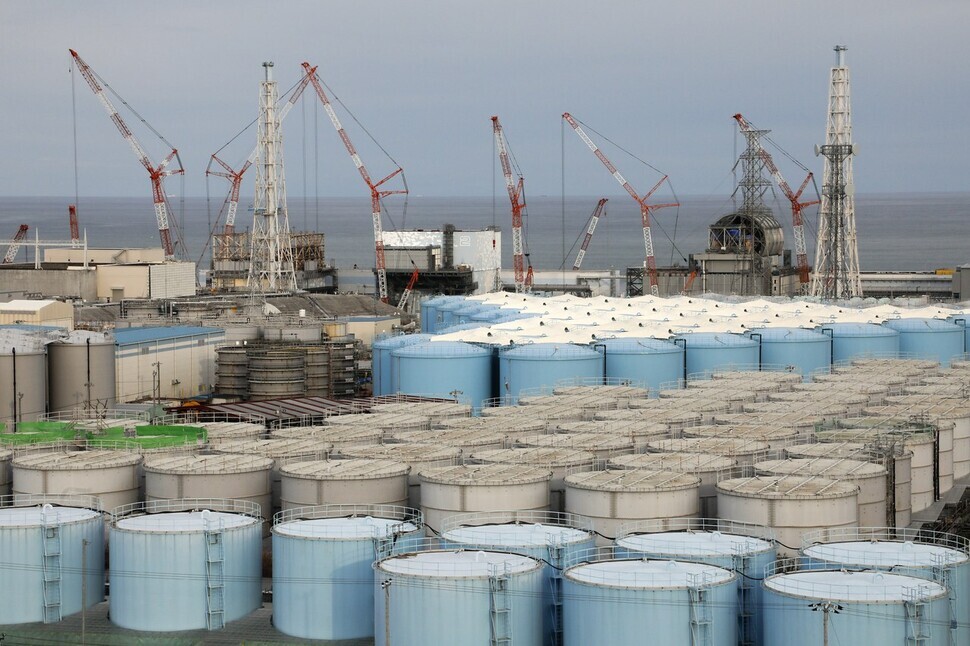hankyoreh
Links to other country sites 다른 나라 사이트 링크
Greenpeace: TEPCO assessment of Fukushima water dumping lacks analysis of impact on S. Korea

The international environmental group Greenpeace sent an opinion to the Tokyo Electric Power Company (TEPCO) on Thursday stating that the company’s radiological impact assessment of contaminated water from the Fukushima Nuclear Power Plant made convenient use of International Atomic Energy Agency (IAEA) guidelines without considering the potential damages to residents of neighboring countries such as South Korea.
The opinion from Greenpeace was based on its review of the draft version of a contaminated water radiological impact assessment report released by TEPCO last month.
In that draft report, TEPCO claimed that the release of contaminated water into the ocean would have a “very limited” impact on the marine environment. The company has announced that it plans to issue a final report Saturday after gathering outside opinions on the draft.
Commenting on the report, Greenpeace East Asia senior nuclear specialist Shaun Burnie called it a piecemeal radiological assessment that was intended to legitimize the discharge of radioactive water into the ocean.
He also said that TEPCO failed to give an adequate scientific basis for its conclusion that the discharge would not cause damage to the waters or marine ecosystem beyond a range of 10 square kilometers.
In its release of the report, TEPCO said it had been drafted in compliance with IAEA guidelines.
But Greenpeace said that an examination showed that TEPCO not only set a “far too narrow” scope of radiological impact assessment targets, but also that it is “highly selective” in its use of IAEA guidelines.
“Ultimately, the potential damages to residents in South Korea and other neighboring countries were not considered in the scope of the current radiological impact assessment,” it explained.
The IAEA General Safety Guide No. GSG-9 document states that radiological impact assessments should take into account the effects of natural radioactivity, nuclear weapons testing, and nuclear power plant accidents, with measurements of radioactivity concentrations in various environmental areas such as water, soil, plants, and grains around the nuclear power plant site.
Greenpeace explained that TEPCO did not perform the kind of comprehensive environmental impact assessment stipulated in the guidelines, nor did it explain about the long-term radiation damage to the maritime ecosystem as the contaminated water is released over a period of at least 30 years.
“It is deliberately vague,” Greenpeace wrote of Japan’s draft. “It does not conclude there will not be adverse effects on species, on the marine environment, on biodiversity or on fish or fisheries or tourism.”
The organization also criticized the report’s omission of the radioactivity contamination pathways identified to date, including study results published by Japan’s Central Research Institute of Electric Power Industry (CRIEPI) last March.
This indicates that TEPCO did not follow the IAEA’s recommendation to reflect the discovery of new contamination pathways for radioactive substances in its assessment, the organization said. Cesium-bearing particles were detected in all seven samples taken by CRIEPI from sediment along the Fukushima coast.
Greenpeace further said that the report did not offer an explanation on why the ocean discharge of contaminated water was unavoidable, nor did it deal at all with the effect that decommissioning the Fukushima Daiichi site would have on the contaminated water.
“The TEPCO radiological impact assessment presumes only that the secondary purification of contaminated water will undoubtedly be successful, which is far from the reality,” said Chang Ma-ri, an anti-nuclear power campaigner with Greenpeace.
“For years now, the ALPS multi-nuclide removal equipment has been failing to fully process highly toxic radioactive substances. Korea and the rest of the international community need to demand that TEPCO examine whether the release of the contaminated water into the ocean is actually unavoidable in scientific and technical terms,” she said.
By Kim Jeong-su, senior staff writer

Editorial・opinion
![[Column] Park Geun-hye déjà vu in Yoon Suk-yeol [Column] Park Geun-hye déjà vu in Yoon Suk-yeol](https://flexible.img.hani.co.kr/flexible/normal/500/300/imgdb/original/2024/0424/651713945113788.jpg) [Column] Park Geun-hye déjà vu in Yoon Suk-yeol
[Column] Park Geun-hye déjà vu in Yoon Suk-yeol![[Editorial] New weight of N. Korea’s nuclear threats makes dialogue all the more urgent [Editorial] New weight of N. Korea’s nuclear threats makes dialogue all the more urgent](https://flexible.img.hani.co.kr/flexible/normal/500/300/imgdb/original/2024/0424/7317139454662664.jpg) [Editorial] New weight of N. Korea’s nuclear threats makes dialogue all the more urgent
[Editorial] New weight of N. Korea’s nuclear threats makes dialogue all the more urgent- [Guest essay] The real reason Korea’s new right wants to dub Rhee a founding father
- [Column] ‘Choson’: Is it time we start referring to N. Korea in its own terms?
- [Editorial] Japan’s rewriting of history with Korea has gone too far
- [Column] The president’s questionable capacity for dialogue
- [Column] Are chaebol firms just pizza pies for families to divvy up as they please?
- [Column] Has Korea, too, crossed the Rubicon on China?
- [Correspondent’s column] In Japan’s alliance with US, echoes of its past alliances with UK
- [Editorial] Does Yoon think the Korean public is wrong?
Most viewed articles
- 1‘We must say no’: Seoul defense chief on Korean, USFK involvement in hypothetical Taiwan crisis
- 2N. Korean delegation’s trip to Iran shows how Pyongyang is leveraging ties with Moscow
- 3Amnesty notes ‘erosion’ of freedom of expression in Korea in annual human rights report
- 4[Column] Park Geun-hye déjà vu in Yoon Suk-yeol
- 5‘Weddingflation’ breaks the bank for Korean couples-to-be
- 6[Reportage] On US campuses, student risk arrest as they call for divestment from Israel
- 7[Editorial] New weight of N. Korea’s nuclear threats makes dialogue all the more urgent
- 8Korea sees more deaths than births for 52nd consecutive month in February
- 9Will NewJeans end up collateral damage in internal feud at K-pop juggernaut Hybe?
- 10Why Korea shouldn’t welcome Japan’s newly beefed up defense cooperation with US